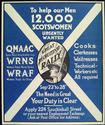 The first women's suffrage society in the city was formed c.1870 and a large open-air women's suffrage meeting was held in April 1872 on Glasgow Green – an unusual event for the time. Campaigning included the sustained, law-abiding efforts of the Glasgow and West of Scotland Association for Women's Suffrage, such as drawing room meetings and petitions to Parliament. After 1906 the militant suffragettes of the Women's Social and Political Union (WSPU) and the breakaway, non-violent Women's Freedom League (WFL) made headlines.
The first women's suffrage society in the city was formed c.1870 and a large open-air women's suffrage meeting was held in April 1872 on Glasgow Green – an unusual event for the time. Campaigning included the sustained, law-abiding efforts of the Glasgow and West of Scotland Association for Women's Suffrage, such as drawing room meetings and petitions to Parliament. After 1906 the militant suffragettes of the Women's Social and Political Union (WSPU) and the breakaway, non-violent Women's Freedom League (WFL) made headlines.
 The WSPU Scottish headquarters was at 141 Bath Street. The WFL had a tea-room and bookshop at 302 Sauchiehall Street. In summer it took the campaign "doon the watter". Glasgow suffragettes took part in window smashing raids in London in 1912. Doctor and minister's wife, Dorothea Chalmers Smith (c.1874-1944) was imprisoned for house-breaking with intent to set fire in Park Gardens in 1913. Domestic servant and trade unionist Jessie Stephen (1893-1979) took part in acid attacks on pillar boxes, but was never caught.
The WSPU Scottish headquarters was at 141 Bath Street. The WFL had a tea-room and bookshop at 302 Sauchiehall Street. In summer it took the campaign "doon the watter". Glasgow suffragettes took part in window smashing raids in London in 1912. Doctor and minister's wife, Dorothea Chalmers Smith (c.1874-1944) was imprisoned for house-breaking with intent to set fire in Park Gardens in 1913. Domestic servant and trade unionist Jessie Stephen (1893-1979) took part in acid attacks on pillar boxes, but was never caught.
 Earlier women's suffrage agitation can be traced in Chartism. A woman weaver from Glasgow argued in 1838 that women deserved the vote. The anti-slavery movement, in which Glasgow Quakers were prominent, led some women to consider equal rights. The cause was championed in print by the socialist newspaper Forward and the popular poet Marion Bernstein. The city council passed a resolution of support. Other key organisations were the Scottish Churches League for Woman Suffrage, and the Men's League for Women's Suffrage started by playwright Graham Moffat after his wife, the actress Maggie Moffat, became the first suffragette to be imprisoned in Scotland. Many campaigners were also involved in labour politics.
Earlier women's suffrage agitation can be traced in Chartism. A woman weaver from Glasgow argued in 1838 that women deserved the vote. The anti-slavery movement, in which Glasgow Quakers were prominent, led some women to consider equal rights. The cause was championed in print by the socialist newspaper Forward and the popular poet Marion Bernstein. The city council passed a resolution of support. Other key organisations were the Scottish Churches League for Woman Suffrage, and the Men's League for Women's Suffrage started by playwright Graham Moffat after his wife, the actress Maggie Moffat, became the first suffragette to be imprisoned in Scotland. Many campaigners were also involved in labour politics.
 When the First World War broke out suffrage campaigners were divided, some supporting the war effort and others, such as Helen Crawfurd (1871-1954), active in the peace movement. Suffrage organisations were involved in the 1915 rent strikes. After women over thirty obtained the vote in 1918, a lower profile campaign continued until the vote was extended to women on the same terms as men in 1928.
When the First World War broke out suffrage campaigners were divided, some supporting the war effort and others, such as Helen Crawfurd (1871-1954), active in the peace movement. Suffrage organisations were involved in the 1915 rent strikes. After women over thirty obtained the vote in 1918, a lower profile campaign continued until the vote was extended to women on the same terms as men in 1928.